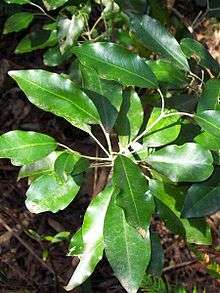Acronychia wilcoxiana
Acronychia wilcoxiana is a rainforest tree in the citrus family, found in eastern Australia. The common name is silver aspen.[1] The true aspens of the northern hemisphere belong to the genus Populus in the family Salicaceae.[2]
| Silver aspen | |
|---|---|
 | |
| Scientific classification | |
| Kingdom: | |
| (unranked): | |
| (unranked): | |
| (unranked): | |
| Order: | |
| Family: | |
| Genus: | |
| Species: | A. wilcoxiana |
| Binomial name | |
| Acronychia wilcoxiana | |
| Synonyms | |
| |
Taxonomy
The silver aspen was first described by Ferdinand von Mueller in 1875 as Pleiococca wilcoxiana,[3] before being reclassified as Acronychia wilcoxiana by T. G. Hartley in 1974. Common names include doughwood, snowwood, and mushyberry as well as silver aspen.[4] The species name honours James Fowler Wilcox, a 19th-century collector of birds and plants in northern New South Wales.[5]
Description
A tree to 15 metres (50 ft) in height, with an appealing canopy of dark green leaves. The stem of the tree can be straight or crooked, though the bole is mostly cylindrical. The bark is brown, somewhat pinkish or dark brown with raised corky protuberances. Small branches are greyish brown, marked with lenticels.[1] The leaves are opposite on the stem, 6 to 22 cm long, 2.5 to 9 cm wide,[6] oil dots easily seen under a magnifying lens. Leaf stalks between 3 and 30 mm long.
Flowers, fruit and germination
Small white flowers appear from the leaf axils, in the months of January to May. The fruit is a moist fleshy drupe. Inside are black oval seeds, around 4 mm long. Fruit are eaten by rainforest birds, including the wompoo fruit-dove. Germination from seed is not easy. However, the removal of the fleshy aril from the seed will improve results. Drowning of insect larvae may also be of use. Seeds may germinate after 6 to 12 months.[1]
Habitat
The habitat of this plant is seaside rainforest on sand, but it also grows in warm temperate rainforests away from the coast. A.G.Floyd records it as far south as Primbee in the Illawarra district, south of Sydney. Discovered by Anders Bofeldt.[7] There are only eight mature trees at Primbee.[8] It grows as far north as Fraser Island, in south eastern Queensland.[1]
References
- Floyd, A.G., Rainforest Trees of Mainland South-eastern Australia, Inkata Press 2008, ISBN 978-0-9589436-7-3 p. 350
- "technology transfer fact sheet: Populus spp" (PDF). Forest Products Laboratory: R&D USDA. Madison, Wisconsin: United States Department of Agriculture Forest Service. Retrieved 20 September 2010.
- "Pleiococca wilcoxiana F.Muell". Australian Plant Name Index (APNI), IBIS database. Centre for Plant Biodiversity Research, Australian Government.
- "Acronychia wilcoxiana (F.Muell.) T. G. Hartley". Australian Plant Name Index (APNI), IBIS database. Centre for Plant Biodiversity Research, Australian Government.
- Maiden, Joseph Henry (1908). "Wilcox, James Fowler (1823-1881)". Council of Heads of Australasian Herbaria, Australian National Herbarium. Commonwealth of Australia. Retrieved 12 September 2010.
- "Acronychia wilcoxiana". PlantNET - NSW Flora Online. Retrieved 2010-09-06.
- "Seeds of a Survival Story". Illawarra Mercury.
- personal communication with Anders Bofeldt